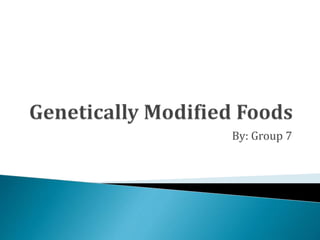
Genetically Modified Foods presentation
- 1. By: Group 7
- 2. GMO stands for “Genetically Modified Organism” and refers to an organism (plant, animal or bacteria) whose DNA has been alerted from its natural form in a laboratory. Genetic engineering is used to development GMO foods using one of two methods. Either specific DNA is injected onto plant cells or a bacterium is used to introduce genetic material into a plant’s DNA. Both plants and animals can be genetically engineered, however to date, only genetically modified plants have been approved from human consumption in the United States. GMO CROP YIELDS: oCanola (approx. 90% of U.S. crop) oCorn (approx. 88% of U.S. crop in 2011) oCotton (approx. 90% of U.S. crop in 2011) oPapaya (most of Hawaiian crop; approximately 988 acres) oSoy (approx. 94% of U.S. crop in 2011) oSugar Beets (approx. 95% of U.S. crop in 2010)
- 4. oFood allergies oMay cause long-term health issues oInsects and weeds may evolve and develop a tolerance to the insecticides and herbicides that were genetically engineered to keep them at bay, making way for a highly destructive superpest and superweed. oGMO’s can cause harm to other organisms by reducing the balance in nature by dramatically decreasing environmental biodiversity. This can happen when a genetically modified crop passes on new traits to relatives in the wild during pollination. Those relatives can be altered in such a way that they take on a completely new ecological role, causing them to out-compete other species in the eco-system (Garcia and Altieri, 2005). How can they harm us ? Possible negative consequences of GMO foods on the environment. oDamage from chemical pesticides and herbicides. Plants are genetically engineered to withstand an increased amount of pesticides and herbicides. The ever-increasing presence of these chemicalsmay cause damage to natural animal and plant life. oInvasive species. Genetically modifying crops may create invasive plant species that are harmful to the natural ecosystem and which may be resistant to herbicides. oLoss of biodiversity. The toxic residues that are produced by GMO plants and their potential inability to replenish the soil with essential nutrients may lead to a loss of biodiversity and degradation of the environment.
- 5. Benefits Positive aspects of GMO foods: oSo far, the health risks associated with GMO food products are only theoretical and no actual adverse health affects have been observed. oOver the past few decades, Americans have consumed trillions of meals containing GMOs and not a single adverse health affect has been observed. oThe use of genetically modified crops has lowered the price of food worldwide and has directly led to a reduction in hunger and starvation. oGenetically modified crops have increased crop yields, allowing farmers to survive who would have failed without the use of GMOs. oWhile a few farmers have increased the use of pesticides and herbicides on genetically modified crops, overall genetic modification has actually led to a reduction in the amount of chemicals used. Benefits (Lessick, Keithley, Swanson, Lemon, 2002): oAgricultural Efficiency – Could help prevent food shortages oDelayed fruit ripening for extended shelf life oEnhanced taste and quality of food
- 6. Possible Solutions Solutions to some of the risks involved in producing and consuming GMOs would be to enforce label laws. This can be beneficial to consumers with allergies, gives consumers the option to choose between organic and GMO. This can also be resourceful in tracking any potential contaminations. However, each country has its own laws set in place in regards to GMO labeling, as seen on the chart.
- 7. Solutions Continued….. Going further another possible solution to the issue of GMO food products would be to ban the production and sale of genetically modified foods. Another solution would involve allowing GMO food products to continue to be produced. In order for our society to make an informed and accurate decision, extensive research should be conducted to determine the true extent of the environmental and human impact of GMO food products. Then, the correct course of action should be taken. However, failure to adequately address the issue of GMO food products may undermine the safety and stability of society. If in fact further research revels that the production of GMO foods severely undermines human and environmental health, then society will be faced with widespread health and environmental issues and perhaps even problems that are presently unforeseen. At the same time, if GMO products are in fact safe, a failure to embrace the technology may result in a loss of economic productivity, and perhaps even a failure to produce enough food to sustain a growing population in the face of worsening climate change.
- 8. Who has the final say? There are 3 federal agencies in the U.S. that are responsible for evaluating new crop varieties developed through genetically modified engineering: oThe Food and Drug Administration (FDA) – evaluate the food and safety of the GMOs oThe Environmental Protection Agency (EPA) – evaluate food, safety, and environmental issues and effects of GMOs oThe United States Department of Agriculture (USDA) – ensures agricultural and environmental safety
- 9. Did you know? Common Genetically Modified Foods and Their Derivatives oSoy 1)Margarine 2)Enriched Flours and Pastas 3)Infant Formula oCorn 1)Bread 2)Chips 3)Alcohol oCanola 1)Candy 2)Oil 3)Canned Soups According to an article in the Wall Street Journal, “Roughly 75% of U.S processed foods – boxed cereals, other grain products, frozen dinners, cooking oils, and more – contain some genetically modified, or GM, ingredients and more than 80% of the soy and 40% of the corn raised in this country is a GM variety.” (Genetically Modified Foods Are Common, But Little Noticed, 2005). Foods that have been created through this process have been commonly referred to as Frankenfoods, in a reference to the popular story, Frankenstein, where a scientist is able to fashion a new human from various parts
- 11. Here’s a controversial video featuring Dr. Oz. Check it out by clicking on the permalink below. https://www.youtube.com/watch?v=m cSATqXSIJY